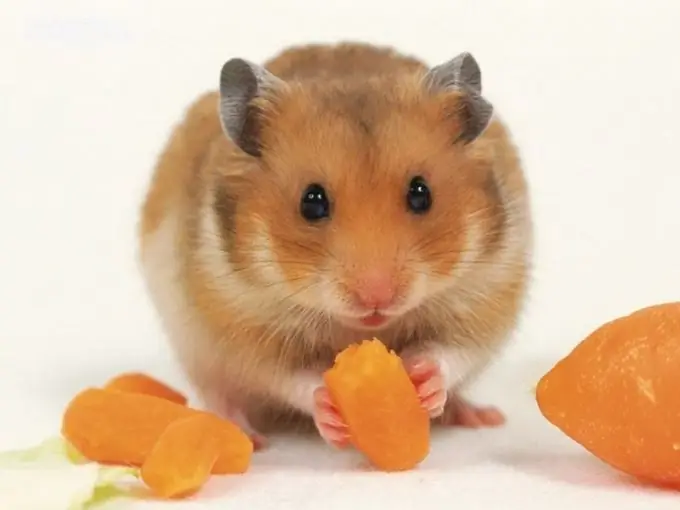Hamsters are small, densely built animals that have small ears and a short tail. They are unpretentious and friendly, they feel great in captivity, so people often keep them as pets.

There are about 240 species of hamsters in the world, of which about 14 species live on the territory of Russia. These animals can be conditionally divided into wild ones, they live in nature - in the steppes, forest-steppes, deserts, and domestic ones, which are kept by humans. Pets are most often Dzungarian and Syrian species, as well as Roborovsky hamsters.
Syrian hamster
Wild Syrian hamsters prefer foothill steppe regions, steppes and crops to live. They settle in burrows one by one. When the air temperature reaches 4 ° C, the hamsters hibernate.
The length of an adult animal is up to 18 cm. The short legs are practically invisible under the thick light wool of the belly. The back is gray with ocher and brown tints, but the most popular color of the hamster is golden.
The main food of the Syrian hamsters living at home is grain, apples, carrots, zucchini, pears, turnips, pumpkin, radishes, persimmons. Additionally, the animal needs to be given crispy food so that its incisors, which grow constantly and quickly, would grind off. The daily amount of food should be such that it remains the next day.
The life expectancy of hamsters in nature rarely exceeds 2 years, while at home, with proper care, this period increases to 3-4 years.
Dzungarian hamster
One of the most popular types of hamsters for home keeping. In nature, it lives in the west of Siberia, in Central and Central Asia, in Kazakhstan. The length of this animal is only about 10 cm. The fur is brownish-gray in color, and there is a dark strip on the back.
Dzungarian hamsters feed mostly on seeds and greens, but do not deny themselves the pleasure of eating insects. For the winter, hamsters stock up on seeds. They do not hibernate.
A very active species, especially at night, therefore, when keeping it at home, you need to choose a spacious cage. You also need to take into account that the animal does not like the company of its relatives, it shows aggression towards them.
The animal is prone to diabetes mellitus, therefore food containing a large amount of monosaccharides is not recommended for it.
Roborovsky's hamster
It is a dwarf hamster, 5-6 cm in size, with pink-fawn fur, white paws and belly.
In nature, Roborovsky hamsters live in loosely fixed sandy deserts overgrown with caragana. The main food is beet seeds, caragana, sedge.
As home food for hamsters, seeds of cereals, beets, sedges, tulips, sunflowers, white bread soaked in milk, as well as vegetables and fruits, and flour worms in small quantities are used. Basically, hamsters of this species sleep during the day and are active at night. The cage contains hamsters in pairs, but only of different sexes.
Hamster Brandt
The hamster of the genus Sredny is widespread in the mountain and foothill steppes of the Anterior and partly Asia Minor and Transcaucasia.
The body length of such a hamster is on average 15 cm. This species is distinguished by the presence of a long tail - up to 3 cm. The color of the coat is earthy-brown, the abdomen is often gray, and between the forepaws on the chest there is always a black spot extending over the shoulders. The paws of the animal are white.
This species prefers to live alone in self-dug burrows that have a complex structure with several passages. In winter, the hamster hibernates, sometimes waking up for several days. It feeds on green parts of plants. Often damages crops. It is a natural carrier of tularemia pathogens and, according to some reports, Q fever.







